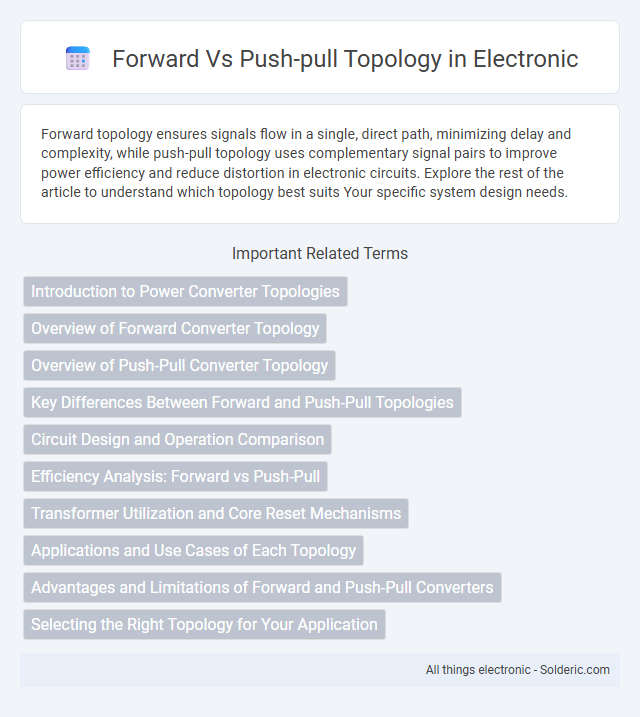Forward topology ensures signals flow in a single, direct path, minimizing delay and complexity, while push-pull topology uses complementary signal pairs to improve power efficiency and reduce distortion in electronic circuits. Explore the rest of the article to understand which topology best suits Your specific system design needs.
Comparison Table
| Feature | Forward Topology | Push-Pull Topology |
|---|---|---|
| Basic Principle | Single switch controls energy transfer | Two switches operate alternately to push and pull current |
| Switching Devices | One primary switch | Two complementary switches |
| Output Transformer Usage | Uses transformer with single-ended primary winding | Uses center-tapped transformer primary winding |
| Efficiency | Moderate efficiency | Higher efficiency due to reduced switching losses |
| Output Power | Suitable for low to medium power levels | Suitable for medium to higher power applications |
| Complexity | Simple design and control | More complex design and control circuitry |
| Voltage Stress on Switches | Higher voltage stress on single switch | Lower voltage stress due to split operation |
| EMI Noise | Moderate EMI noise levels | Reduced EMI noise due to balanced switching |
| Typical Applications | Low-power DC-DC converters, simple power supplies | Medium to high-power supplies, audio amplifiers |
Introduction to Power Converter Topologies
Forward and push-pull topologies are fundamental power converter designs used for voltage transformation and isolation in DC-DC converters. Forward converters utilize a single transistor and transformer, efficiently transferring energy during the on-time, making them suitable for medium-power applications with better efficiency at higher frequencies. Push-pull converters employ two transistors driving the transformer alternately, enabling symmetrical magnetic flux utilization, higher power output, and improved transformer core utilization in applications requiring medium to high power levels.
Overview of Forward Converter Topology
Forward converter topology efficiently transfers energy from input to output using a transformer and an active switch, enhancing voltage regulation and isolation. It operates by storing energy in the transformer during the switch on-state and delivering it to the output when the switch turns off, minimizing energy loss and improving efficiency. Your power supply design benefits from the forward converter's simplicity and ability to handle medium power levels with reduced electromagnetic interference compared to push-pull topology.
Overview of Push-Pull Converter Topology
The push-pull converter topology employs two transistors that alternately switch, driving the transformer's primary winding to deliver power efficiently while minimizing voltage stress on each device. This configuration provides a balanced load and improved transformer utilization, making it suitable for medium-power applications with moderate voltage requirements. The push-pull converter achieves higher efficiency and reduced magnetic component size compared to single-ended topologies, thanks to its symmetrical operation and effective transformer reset mechanism.
Key Differences Between Forward and Push-Pull Topologies
Forward topology uses a single transistor to switch current through the transformer's primary winding, resulting in simpler design and lower cost, while push-pull topology employs two transistors that alternately drive the transformer, providing greater power output and improved efficiency. Forward converters typically have continuous input current and require a reset winding for transformer demagnetization, whereas push-pull converters rely on transformer center-tapping and naturally reset the core during each switching cycle. Your choice between these topologies depends on power level, complexity, and efficiency requirements of your application.
Circuit Design and Operation Comparison
Forward topology utilizes a single transistor to switch power to the transformer, resulting in simpler circuit design and lower component count. Push-pull topology employs two transistors that alternately drive the transformer, providing better transformer utilization and higher efficiency at the cost of increased circuit complexity. Your choice depends on balancing design simplicity with performance requirements in power conversion applications.
Efficiency Analysis: Forward vs Push-Pull
Forward converters typically achieve higher efficiency at lower power levels due to simpler magnetics and reduced switching losses, making them suitable for compact, low-power applications. Push-pull converters excel in medium to high power ranges by distributing the load more evenly across the transformer windings and improving utilization of the magnetic core, leading to better efficiency under heavier loads. However, push-pull topologies may suffer from increased complexity and potential core saturation issues, which can reduce efficiency if not properly managed.
Transformer Utilization and Core Reset Mechanisms
Forward topology achieves higher transformer utilization by transferring energy only during the switch-on period, minimizing core saturation and enabling efficient power conversion. Push-pull topology requires core reset mechanisms, often using a center-tapped transformer to prevent saturation by reversing magnetization during alternate switching cycles. Your choice between these topologies depends on balancing transformer efficiency and the complexity of core reset management to optimize performance.
Applications and Use Cases of Each Topology
Forward converters excel in medium-power applications such as telecommunications, industrial equipment, and consumer electronics where simple design and efficient regulation are needed. Push-pull topology suits high-power applications like audio amplifiers, RF transmitters, and electric vehicles, offering improved power handling and transformer utilization. Both topologies serve distinct roles based on power requirements and efficiency demands in power conversion systems.
Advantages and Limitations of Forward and Push-Pull Converters
Forward converters offer simplicity and better efficiency at low power levels, making them suitable for applications requiring cost-effective power conversion. Push-pull converters provide higher power output and improved transformer utilization, but they suffer from increased complexity and potential core saturation issues. Choosing your converter depends on balancing efficiency, power requirements, and design complexity.
Selecting the Right Topology for Your Application
Choosing between forward and push-pull topologies depends on your application's power requirements and efficiency goals. Forward topology offers simpler design and is ideal for low to medium power levels, while push-pull topology supports higher power with improved transformer utilization and reduced core size. Assessing your load characteristics and efficiency expectations helps determine the most suitable topology for optimal performance.
forward vs push-pull topology Infographic

 solderic.com
solderic.com